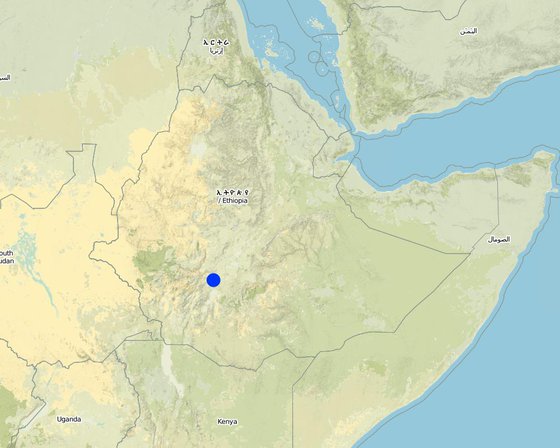Microcatchments and ponds
(埃塞俄比亚)
Wuha Masebaseb
描述
Microcatchments and ponds are water harvesting measures used to collect stored and spread over an area to increase soil moisture and ground water level.
Microcatchments for crop fields involve the construction of physical measures which trap rain water and help in increasing infiltration. Soil and stone funds, microbasics, ridges and tied ridges are some of the sWC pracices known as microcatchment. They are designed taking into account the amount of rain received the infiltration capacity of soils and the runoff produced from the field.
Water harvesting techniques described here are the most widely practiced techniques in Alaba woreda, which is characterised by erratic rains, soils having very low water holding capacity and farming systems dominated by seasonal cereal crops such as maize, teff and pepper. Maize is the dominant food and cash crop grown in the wereda. It is a crop requiring more rainfall than teff and sorghum. Water harvesting techniques are more suitable to maize because these structures make more water available to the crop. Bunds are establised by digging channel and embanking the soil either on the upper side or on down ward direction. Wherever stone is abailable it is supported by stone lines at the down slope direction. The purpose is to collect, stone and enhance infiltration of rain water in the soil for increasing survival and productivity of crops planted on the field. The technology is suitable to areas with erratic and low rainfalls, soils with low soil moisture holding capacity and for crops which require more water. The annual rainfall is not small but is not well distributed over the growing period and hence it becomes essential to have structures that could trap and store as much rainfall as possible in the soil.
地点

地点: Bilate watershed, SNNPR, 埃塞俄比亚
分析的技术场所数量:
技术传播:
在永久保护区?:
实施日期: 50多年前(传统)
介绍类型
-
通过土地使用者的创新
-
作为传统系统的一部分(> 50 年)
-
在实验/研究期间
-
通过项目/外部干预
主要目的
-
改良生产
-
减少、预防、恢复土地退化
-
保护生态系统
-
结合其他技术保护流域/下游区域
-
保持/提高生物多样性
-
降低灾害风险
-
适应气候变化/极端天气及其影响
-
减缓气候变化及其影响
-
创造有益的经济影响
-
创造有益的社会影响
土地利用
-
农田
- 一年一作: 谷物类 - 玉米, 谷类 - 高粱, 豆科牧草和豆类 - 豆子, 蔬菜 - 叶菜(色拉、卷心菜、菠菜和其他), haricot bean
- 多年一作(非木材): 药用、芳香、杀虫植物 - 多年生植物, pepper, Teff
- 乔木与灌木的种植
每年的生长季节数: 1
供水
土地退化相关的目的
-
防止土地退化
-
减少土地退化
-
修复/恢复严重退化的土地
-
适应土地退化
-
不适用
技术建立与维护:活动、投入和费用
投入和成本的计算
- 计算的成本为:
- 成本计算使用的货币:Birr
- 汇率(换算为美元):1 美元 = 8.6 Birr
- 雇用劳工的每日平均工资成本:不适用
影响成本的最重要因素
Availability of construction materials.
技术建立活动
-
Site selection (时间/频率: None)
-
Survey (时间/频率: dry season)
-
Construction (时间/频率: dry season)
技术建立的投入和成本
| 对投入进行具体说明 |
单位 |
数量 |
单位成本 (Birr) |
每项投入的总成本 (Birr) |
土地使用者承担的成本% |
|
劳动力
|
| Labour |
ha |
1.0 |
83.7 |
83.7 |
|
|
设备
|
| Tools |
ha |
1.0 |
120.0 |
120.0 |
|
|
施工材料
|
| Plastic |
ha |
1.0 |
232.0 |
232.0 |
|
| 技术建立所需总成本 |
435.7 |
|
| 技术建立总成本,美元 |
50.66 |
|
技术维护活动
-
Surveying (时间/频率: dry season / annual)
-
Rainwater structure construction (时间/频率: dry season / annual)
-
Clearing silt trap (时间/频率: dry season/annual)
-
Stablizing the bunds (时间/频率: rainy season/annual)
技术维护的投入和成本
| 对投入进行具体说明 |
单位 |
数量 |
单位成本 (Birr) |
每项投入的总成本 (Birr) |
土地使用者承担的成本% |
|
劳动力
|
| Labour |
ha |
1.0 |
6.97 |
6.97 |
|
|
设备
|
| Tools |
ha |
1.0 |
120.0 |
120.0 |
|
| 技术维护所需总成本 |
126.97 |
|
| 技术维护总成本,美元 |
14.76 |
|
自然环境
年平均降雨量
-
< 250毫米
-
251-500毫米
-
501-750毫米
-
751-1,000毫米
-
1,001-1,500毫米
-
1,501-2,000毫米
-
2,001-3,000毫米
-
3,001-4,000毫米
-
> 4,000毫米
关于气候的规范
850-950 mm
斜坡
-
水平(0-2%)
-
缓降(3-5%)
-
平缓(6-10%)
-
滚坡(11-15%)
-
崎岖(16-30%)
-
陡峭(31-60%)
-
非常陡峭(>60%)
海拔
-
0-100 m a.s.l.
-
101-500 m a.s.l.
-
501-1,000 m a.s.l.
-
1,001-1,500 m a.s.l.
-
1,501-2,000 m a.s.l.
-
2,001-2,500 m a.s.l.
-
2,501-3,000 m a.s.l.
-
3,001-4,000 m a.s.l.
-
> 4,000 m a.s.l.
土壤深度
-
非常浅(0-20厘米)
-
浅(21-50厘米)
-
中等深度(51-80厘米)
-
深(81-120厘米)
-
非常深(> 120厘米)
土壤质地(表土)
-
粗粒/轻(砂质)
-
中粒(壤土、粉土)
-
细粒/重质(粘土)
土壤质地(地表以下>20厘米)
-
粗粒/轻(砂质)
-
中粒(壤土、粉土)
-
细粒/重质(粘土)
水质(未处理)
-
良好饮用水
-
不良饮用水(需要处理)
-
仅供农业使用(灌溉)
-
不可用
应用该技术的土地使用者的特征
非农收入
-
低于全部收入的10%
-
收入的10-50%
-
> 收入的50%
个人或集体
-
个人/家庭
-
团体/社区
-
合作社
-
员工(公司、政府)
每户使用面积
-
< 0.5 公顷
-
0.5-1 公顷
-
1-2 公顷
-
2-5公顷
-
5-15公顷
-
15-50公顷
-
50-100公顷
-
100-500公顷
-
500-1,000公顷
-
1,000-10,000公顷
-
> 10,000公顷
土地所有权
-
州
-
公司
-
社区/村庄
-
团体
-
个人,未命名
-
个人,有命名
采用和适应
在所有采用这种技术的人当中,有多少人在没有获得物质奖励的情况下采用了这种技术?
-
0-10%
-
11-50%
-
51-90%
-
91-100%
最近是否对该技术进行了修改以适应不断变化的条件?
什么样的变化条件?
-
气候变化/极端气候
-
不断变化的市场
-
劳动力可用性(例如,由于迁移)
结论和吸取的教训
长处: 土地使用者的观点
-
Vegetables grown around water harvesting structures.
长处: 编制者或其他关键资源人员的观点
-
Moisture is harvested
-
shortage of water gradually decreased
弱点/缺点/风险: 土地使用者的观点如何克服
弱点/缺点/风险: 编制者或其他关键资源人员的观点如何克服
参考文献
审查者
-
Deborah Niggli
-
Alexandra Gavilano
实施日期: June 2, 2011
上次更新: Sept. 9, 2019
资源人
-
Melese Teshome - SLM专业人员
-
Simeon Kisum - SLM专业人员
文件编制者
机构
- Ministry of Agriculture and Rural Development of Ethiopia (Ministry of Agriculture and Rural Development) - 埃塞俄比亚
- SNNPR Bureau of Agriculture - 埃塞俄比亚
项目
主要参考文献
-
Guideline for watershed development:







